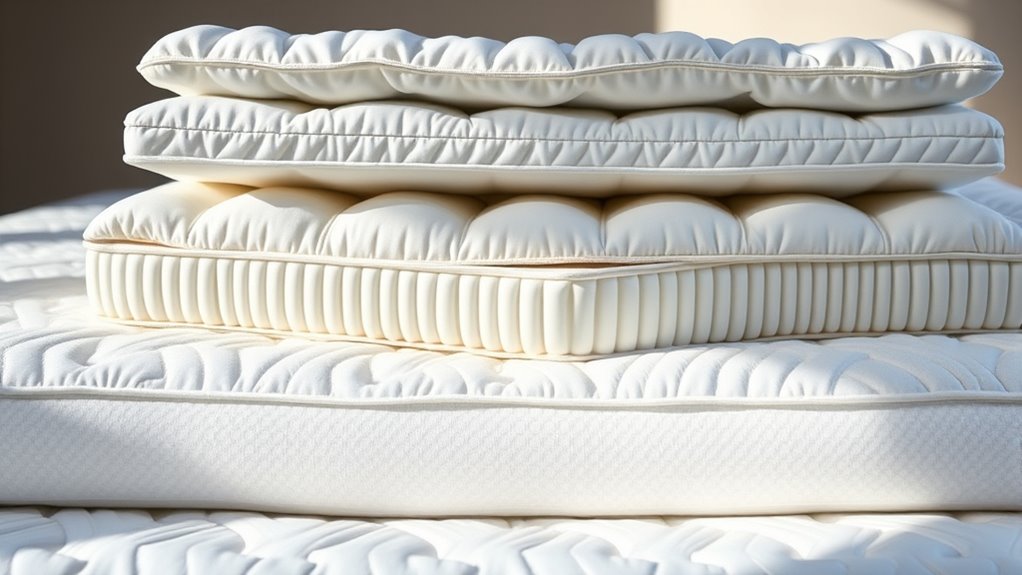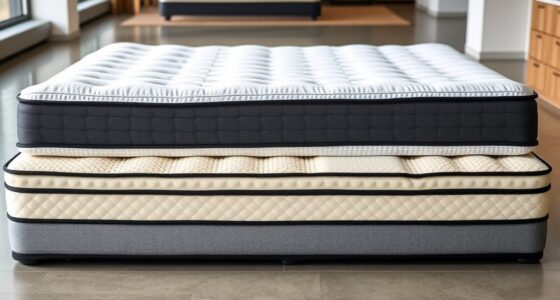A mattress topper adds extra comfort and support to your bed by layering on materials like memory foam, latex, or soft fabrics such as down and wool. It can help relieve pressure points, improve spinal alignment, and extend your mattress’s lifespan. Cooling features and anti-allergen properties are available to suit your specific needs. If you want to discover more about the different types and how they can transform your sleep, keep exploring further.
Key Takeaways
- Mattress toppers enhance comfort, support, and can extend mattress lifespan by reducing wear.
- Different materials like memory foam, latex, and down offer tailored benefits such as pressure relief and responsiveness.
- Features like anti-allergen properties and cooling technology improve sleep quality and address specific health needs.
- Regular maintenance, including cleaning and flipping, helps preserve the topper’s longevity and performance.
- Using a topper can significantly improve sleep quality, support spinal alignment, and relieve pressure points.

A mattress topper is an additional layer placed on top of your existing mattress to enhance comfort, support, and sleep quality. They come in various materials such as memory foam, latex, down, and wool, each offering different benefits tailored to individual preferences. Memory foam toppers, for instance, contour to the body’s shape, providing pressure relief and improving spinal alignment. Down and wool options add a plush, soft feel that can make a bed feel more luxurious. Selecting the right topper can also help extend the lifespan of your mattress by reducing wear and tear. Proper maintenance, including regular cleaning and occasional flipping or rotation, ensures longevity and sustained comfort. Additionally, some toppers feature anti-allergen properties or cooling technologies, catering to specific health needs or comfort preferences. These accessories can significantly improve sleep quality, especially for those with back pain or allergies.
Frequently Asked Questions
How Often Should I Replace My Mattress Topper?
You should replace your mattress topper every 1 to 3 years, depending on its lifespan and how well you maintain it. Regular maintenance tips like washing it regularly and checking for signs of wear can extend its comfort and support. If you notice persistent sagging, stains, or loss of cushioning, it’s time for a replacement. Proper upkeep guarantees your mattress topper continues to provide the comfort and benefits you need.
Are Memory Foam Toppers Suitable for Hot Sleepers?
Memory foam toppers can be suitable for hot sleepers, especially if they feature cooling technology designed to dissipate heat and improve airflow. Look for options with gel-infused or breathable materials to enhance comfort. Additionally, these toppers often offer allergen resistance, making them a good choice for sensitive sleepers. By choosing a memory foam topper with cooling features, you can enjoy a cooler, more comfortable night’s sleep.
Can Mattress Toppers Help With Back Pain Relief?
Yes, mattress toppers can help relieve back pain by enhancing pillow support and adjusting mattress firmness. If your current mattress is too firm or too soft, a topper can provide the right cushioning or support to align your spine properly. This added comfort reduces pressure points and minimizes back discomfort, helping you wake up feeling refreshed. Choose a topper that matches your specific back pain needs for the best relief.
Do Mattress Toppers Impact Mattress Warranty?
Wondering whether mattress toppers mess with your mattress’s warranty? Well, warranty implications depend on mattress compatibility. You should check your mattress’s warranty terms because some brands may void the warranty if toppers cause damage or if they aren’t compatible. To avoid adverse effects, choose toppers that align with your mattress’s specifications and always review warranty policies before adding extra layers. Being cautious can protect your purchase and preserve your peace of mind.
What Is the Best Thickness for a Mattress Topper?
The best thickness for a mattress topper depends on your comfort needs, usually between 2 and 4 inches. Thicker toppers with gel infusions can add extra cushioning and temperature regulation, while those made from hypoallergenic materials help reduce allergy symptoms. If you prefer more support, go for a thinner layer. Ultimately, choose a thickness that balances comfort, support, and your specific preferences for a restful night.
Conclusion
So, next time you’re debating a new mattress, consider a topper instead. It’s like giving your bed a secret upgrade without the hefty price tag. Some say they can even improve sleep quality by providing extra support and comfort, and science suggests that a better night’s sleep boosts overall health. So, don’t overlook this simple fix—you might find yourself waking up refreshed and ready to conquer the day!









